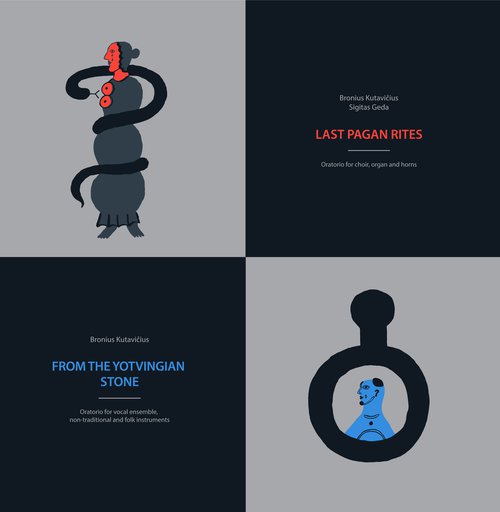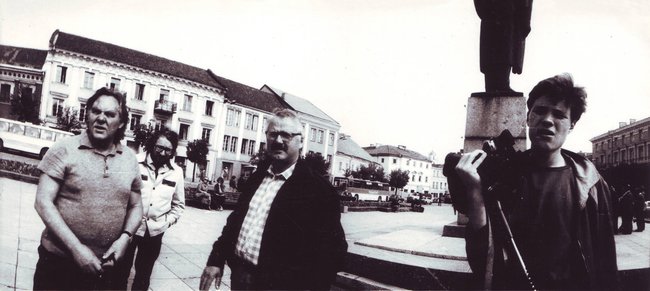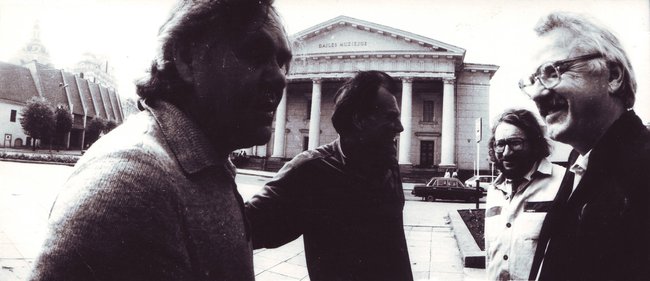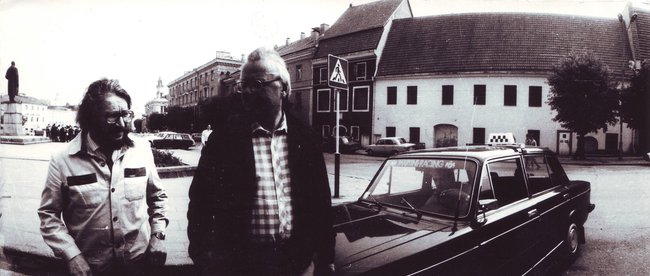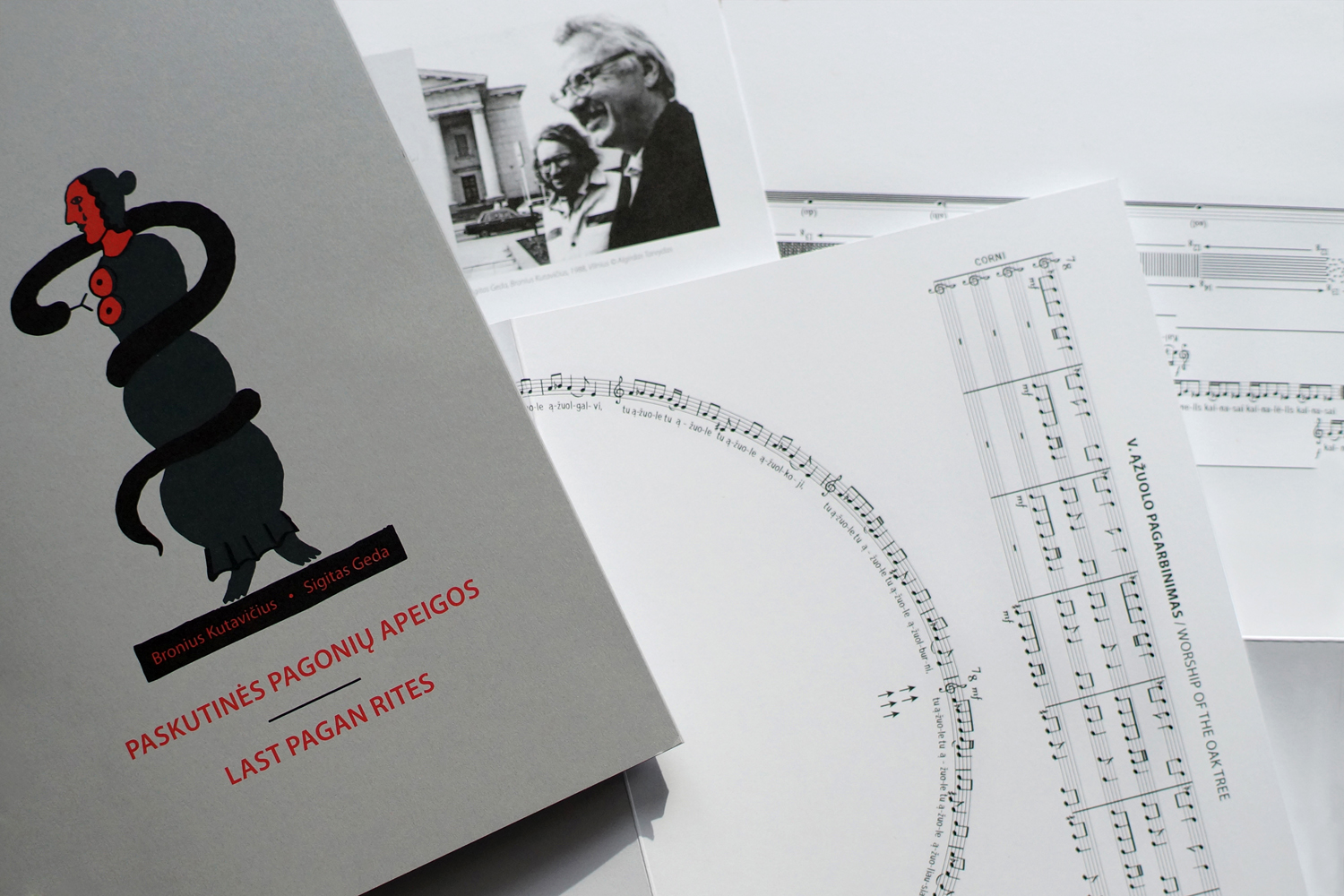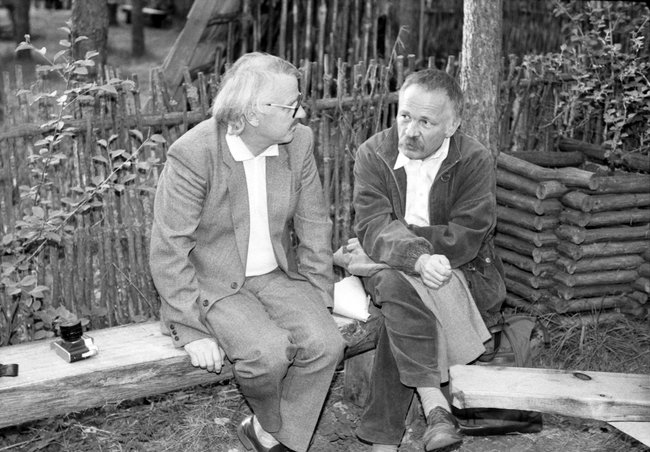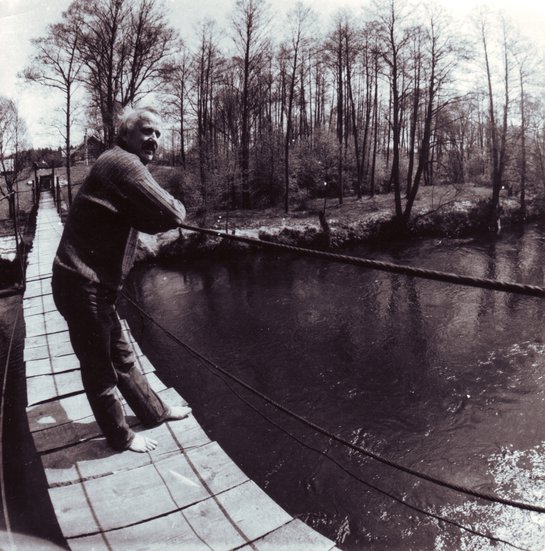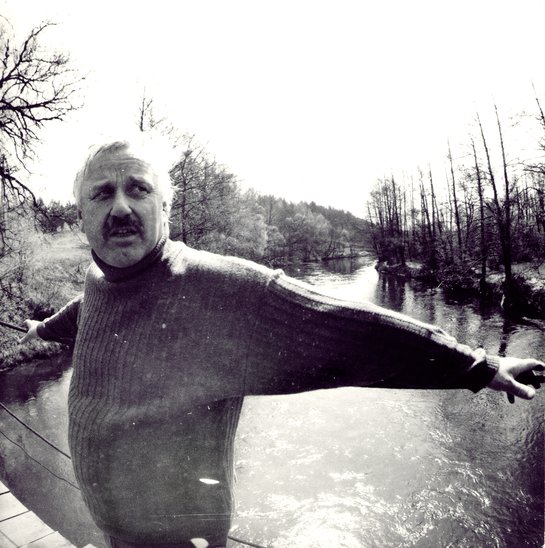Dainius Razauskas: ‘Christianity constructed paganism as its shadow, as its dark side’
- Nov. 21, 2019
Dr Dainius Razauskas, an ethnologist, mythologist, researcher into religion, and writer, is interviewed here by the musicologist Sigita Ilgauskaitė.
Sigita Ilgauskaitė: Bronius Kutavičius’s compositions have already received a lot of attention from musicologists and that’s why it would be interesting to take a step back and look at things from a different perspective, in view of the fact that the oratorios themselves fit into quite a wide context. I think, nobody can deny that Kutavičius delved into the past, the flow of time and in his music created spectacles - imagined rituals. Both oratorios are connected, both look back to the past. Have you been to live performances?
Dainius Razauskas: Yes, I attended a performance very recently. It left a very deep impression…
S.I.: To this day, the oratorios are still being performed quite frequently. It would most perhaps be quite interesting for many of those who have heard them to find out about the musical rituals created by the composer and the pagan imagery used by him because it’s especially hard, if not impossible, to find specific information about, let’s say, the musical legacy of the Yotvingians…
D.R. Since you’ve said that these compositions have already been extensively examined from a musicological angle, I’m not going to speak about the music. However, music inevitably expresses a certain mood, and this mood can be expressed through other means as well, through other forms of art – painting and poetry. The poet Sigitas Geda, the graphic artist and creator of frescos Petras Repšys, the composer Bronius Kutavičius, all three represent different aspects of the arts and are linked by a common outlook. In connection with that we should begin with the very distant past. Perhaps even from the fact that in so-called primitive nations and generally speaking in old traditions the term ‘human being’ and the name for one’s own nation often coincide. A foreigner isn’t thought of as being quite a human being. For the ancient Greeks ‘people’ or ‘human beings’ were those that lived in the lands they had conquered and civilized and who spoke Greek, while all the rest were ‘barbarians’, basically not human or not quite human. The ancient Greek word βάρβαρος (bárbaros) literally means someone who babbles producing ‘bar bar’ sounds, i.e. someone who doesn’t know how to speak properly (because the true language is Greek) and is therefore a savage or half-animal. Similarly, the Slavs call the Germans немцы (niemtsy), literally ‘mute’, while the Belarusians use to call Lithuanians ‘gargatun’, because they also don’t speak a human language.
Why am I reminding you of this? Because it was characteristic of people from ancient times to affirm and exalt themselves at the expense of others, ridiculing and humiliating them, however gently. We are human beings, our customs are the real culture, our religion – the one and true religion. ‘They’, on the other hand, are always obscure, incomprehensible losers, their customs – ridiculous oddities, their religion – a path taken in mistake. The Christians viewed their relationship with the pagans in the same way as they did with the other. There has never been such a thing as paganism in the world nor is there now, paganism appears when and wherever Christianity appears. And Christianity cannot survive without paganism. As soon as paganism stops existing somewhere, Christians immediately start to argue amongst themselves and begin to call each other pagans, as the Catholics do the Eastern Orthodox Christians, and the Eastern Orthodox Christians together with the Protestants do the Catholics, etc. This confrontational approach is necessary because the whole structure of the Christian character is based on self-justification blaming and scorning others. After Lithuania’s rulers decided to accept Christianity, Polish Christianity identified a righteous Christian as a Pole, and a Lithuanian as a pagan heretic. So, besides the religious difference, there was also the national one. Everything that had formerly been Lithuanian became pagan. The Lithuanian language right up to the middle of the 20th century was called język pogański (the pagan language) in Polish and even occasionally is still called that. The whole Lithuanian nation was written off as backward and savage.
Gintaras Beresnevičius (1961-2006), a Lithuanian historian who specialized in the early Baltic religions, very aptly pointed out that the two 19th century schools of researchers in Lithuanian mythology, the positivists and the romantics, can be aligned with national self-awareness (self-awareness and not origin): the positivists who cavil, disparage, mock, looking down from on high, and employ irony are the ‘real’ Poles, while the dreamers and romanticists who wish to elevate the Lithuanian past are Lithuanians, even though many of them gladly spoke, read and wrote in Polish. In other words, those who identified themselves with a great Lithuania were romantics, while those who identified themselves with Poland and looked at Lithuania as proof of the superiority of Polish culture were positivists. Beresnevičius very ably compared this situation to colonialism and it was roughly at the same time that a movement for nations to free themselves of colonialism began throughout the world. It appears that the colonial ideology of oppression is always positivist, while the ideology of liberation from colonial oppression is romantic. So-called romanticism, both in literature and in academic studies, began to flourish in Lithuania because the Lithuanians, like other nations, began to awaken and free themselves from the Christian Polish colonialism that had been foisted on them. Polish positivism, on the contrary, mocked, disproved of and sought to crush that movement of the Lithuanians to free themselves – ‘what are these savages jumping around for, what are they freeing themselves from, after all, they don’t have anything – it was we who gave them everything.’ By the way, this was also the principle followed by the Russian Bolsheviks. In essence, this is the principle followed by all aggressors because aggression begins firstly in the soul, in thoughts when the other is devalued and scorned.
And this is where the view of the old Lithuanian spiritual tradition as some sort of savage oddity, a backward anti-culture, anti-civilization comes from. Bearded fur-wearing and flea-infested primitives. (Although in fact in terms of hygiene the Lithuanians were superior to those living in Western Europe by several centuries, whereas the real unwashed were the Western Christians of the late Middle Ages and the Renaissance, who were afraid of nakedness and forbade bathing in bathhouses.)
Jean-Jacques Rousseau held up the noble savage as a model, but that is only the flipside of the same attitude to reject and degrade: the primitive savage suddenly becomes the primordial, unspoiled by civilization, noble creature living in a ‘holy’ way in nature (the ancient Romans sometimes viewed the ‘barbarians’ they conquered in the same way). The Romantics also elevated the ancient Lithuanians in a very similar way – leaving them with the ‘privilege’ of primitive savagery.
And this is the ‘paganism’ that reached the 20th century. It’s hard even now for scholars to divest themselves of this relationship and the images it brings up. Open up books on this subject and sooner or later you’re bound to read there that the ancient Lithuanians worshipped nature. But that is complete and utter delusion and has absolutely nothing to do with reality. No one anywhere in the world has ever ‘worshipped’ ‘nature’. To tell the truth, even the very concept of ‘nature’ is questionable, in particular the opposition between ‘culture’ and ‘nature’ in Western tradition… Especially because of the Latin word nātūra being translated into Lithuanian with two words: gamta ‘nature; the natural world’ and prigimtis ‘nature or quality of a thing; character’, splitting up the primary content of the concept. In spite of that, for over 500 years we’ve told that the ancient Lithuanians ‘worshipped nature’. Why? ‘They did not know the real God’ because they were ‘wild pagans’.
S.I.: However, one can find quite a lot of articles in which it’s stated that the ancient Lithuanians worshiped oaks, lightning, thunder, fire and natural phenomena…
D.R.: One can find articles like that but what are they worth if the facts aren’t questioned? And what should be questioned is not only the use of the words ‘nature’ and ‘worship’. Yes, the Christians worship the one and true God. They glorify and praise him and kneel down before him and so on. And what then do those heathen backward pagans worship? They don’t even recognize God! But it’s clear what they do recognize – the creations of God, all kinds of natural phenomena and living things. They worship the celestial lights – the sun, the moon, and the stars; atmospheric phenomena – thunder, the clouds, rain; all kinds of earthly bodies – bodies of water, the mountains, rocks; as well as plants and animals – trees, slugs, even frogs and toads. But if we look at things honestly, without preconceptions and a disparaging agenda, religious practices throughout the world are very similar. And you won’t find such a thing as the worship of ‘nature’ or any kind of natural object. Because a thing can have a religious meaning only when it becomes a symbol – a sign, pointing to something quite different than a thing or ‘nature’. A religious relationship with the world is in itself symbolic. ‘Symbolic’ is can be taken to mean the same as ‘religious’.
Imagine that you’re living surrounded by forests and woods, you get up in the morning, you come out of your wooden fort or your cottage without a chimney and all around you is forest. So, what should be worshipped? People did, after all, cut down the trees in those forests and made and built all manner of things out of them, as well as using them to heat their homes. And, of course, there were no chainsaws in those days. In the deep past all one had was a stone axe to work with. Perhaps if you were to tell a person in those days that he worshipped the forest he would think there was something wrong with your brain. But there’s a special tree somewhere in a field or on a hill that’s considered to be sacred and for that reason it’s fenced off – just like a present-day ‘nature monument’. Why are all the other 100,000 trees not sacred but only this one? What’s that got to do with ‘nature’. It’s not nature at all that determines this difference between the sacred and not sacred but an inner, spiritual culture, a certain narrative, establishing relationship and value, defining the causes, conditions and features of how things are to be evaluated. Such a narrative, for example, is the Bible without which all the idols representing the saints, Mary and the Crucified Christ would be deprived of their basis for existence. You might say that it’s not idols that are worshipped in Christianity but what they represent and what they remind us of. And why do you think it’s different in other traditions?
No stone or tree has any value in itself – its value and meaning are determined by the attitude maintained in a relevant narrative, which makes up the framework of a worldview and the emotional connection with the world one holds. A particular tree stands out from other trees only because certain features of that tree are given meaning by an appropriate narrative. Without that narrative it is nothing. Exactly the same holds true in Christianity. Jerusalem only exists because of the biblical narrative. If that narrative didn’t exist. Jerusalem would only be a backwater, with nothing differentiating it from a host of other boring places. For the Muslims it’s Mecca. What is sacred or not depends on the narrative, and the narratives themselves and the attitudes expressed in them make up the inner culture of a community. And if it seems that some thing is ‘worshipped’ by a community, it’s only because the culture of that community has singled it out from nature.
Of course, if one wishes to enslave a community one has to destroy its narratives, and if that doesn’t work, then to forbid them, and if that doesn’t work, then to negate and ridicule them, and put one’s own narratives in their place, so that the community will always become second-rate, inferior and dependent.
From all of that it should be clear the old Lithuanian religious-spiritual tradition was no kind of wild ‘paganism’ practiced by some backward cranks. It’s entirely possible that the Lithuanian tradition viewed the incoming Christians as wild barbarian and itself as the real culture with its true faith at the core. The only difference being that that tradition was an oral and not a written one. However, it wasn’t exceptional in thinking that since all the great traditions of the world up to a certain period in history, each one it its different way, were oral, and some, like the ancient Gaelic Druids, considered a written narrative as a cultural decline and firmly refused to write down their sacred texts, even though they were familiar with writing and used it for economic and political matters. In India oral tradition lives on to the present day, now for about 5000 years, in spite of a knowledge of writing. So, Lithuania is not an exception. However, our oral tradition was suppressed by an imported religion, that is, Christianity, which viewed itself only positively and all other religions only negatively and destroyed whatever it could as best as it could.
But at the end of the 18th century Europe turned back to look at a layer of its population that had up to that time been almost completely ignored, namely the peasants that worked on the land and the literate European found ‘the noble savage’ right next to him, right under the windows of his mansion. Suddenly, the folk tales of the Brothers Grimm became hugely popular throughout all of Europe. And everyone was amazed: what vitality, what freshness! Even though the storytellers, of course, were illiterate, uneducated savages. In Lithuania this was transferred to the old tradition.
So. this relationship with ‘paganism’ has been going on for about 200 years and continues.
First of all, Christianity suppressed the mature content of the old tradition, which in all traditions a minority of knowledgeable people represent, distorted its image and instilled a view from on high, a contempt, a disgust, and rejection. Later, that work was continued by researchers who were positivists, while romanticists turned the relationship on its head, but basically did not avoid the ‘primaeval wild’ image, even one regarded as being noble. Finally, the Soviets who came in banned Christianity itself, and what was left was that noble wild nature worshipper, into which all one’s hopes were places.
This relationship is very clearly embodied in Petras Repšys’s frescoes in the Department of Baltic Studies at the University of Vilnius, where all the characters are odd freaks, who don’t know what they’re doing, seemingly ‘worshipping’ their own stones and trees because they are a priori savages, only now portrayed with a peculiar romantic nostalgia and with that one remaining non-forbidden religiousness. The other clear examples of the same relationship are Sigitas Geda and Bronius Kutavičius. There are also the scholars – Pranė Dundulienė, in part Marija Gimbutienė and even Norbertas Vėlius. Later, we have semiotics in the shape of Algirdas Julius Greimas. Then it appears that those images are in fact symbolic, they have a certain meaning, which, it seems, can be ‘reconstructed’ with the help of semiotics. This elevates the relationship to some degree but nevertheless leaves the old tradition and the ancient Lithuanians in a peculiar cabinet of curiosities which can only attract the attention of lovers of the odd.For this reason, Kunst, the German word for ‘art’, comes first to mind. After all, Kutavičius’s ‘pagan rites’ are the ‘final’ ones. Because of that paganism, being primordial and wild, having been left behind long ago, whereas we are cultured and civilized. The only thing that links us to it is perhaps sentiment – in the same way as sentiment links a professor to his native village. On the one hand, from above, on the other – also from the heart. This somewhat wistful warm sentiment is meaningless but can be considered forgivable. In the same way as the love of a ‘civilized Christian’ for his homeland. In other words, ‘the last pagan rites’.
The folklore movement Ramuva, also from the Soviet period, tapped into a rich vein – the folk tradition, the living continuation of the old tradition. Sutartinės and other ancient folk songs are being revived and transferred to an urban environment. There is no disparaging aspect here, an attempt is being made to go deeper into things, to clarify things, to understand, and whatever really becomes understood becomes automatically revived. But that is no longer ‘paganism’.
In this respect, what I’m saying is that from the very beginning paganism has been a construct. Christianity constructed it as its own shadow, as its dark side. For this reason, it’s worth having in mind a corresponding example from the Soviet period. The main accusation made against someone by the Communist Bolsheviks was ‘bourgeois nationalist’. So ‘paganism’ from the Christian point of view is the same as ‘bourgeois nationalism’ from the Soviet. If the Soviet Union had survived 50 and not 500 years, like Christianity, then some other Kutavičius would have composed The Last Rites of Bourgeois Nationalists. For this reason, all this ‘paganism’ is worth as much as ‘bourgeois nationalism’. The Soviet Union collapsed and no trace of ‘bourgeois nationalism’ survived.
S.I.: But we are trying to explain to ourselves how the ancient Balts, Yotvingians and other nations lived, because artists are affixing a whole host of interpretations to this past, using a very wide variety of creative tools. For example, Bronius Kutavičius in The Last Pagan Rites uses minimal tools, a graphic score, on the other hand, he also looks back to the sutartinės, the lines of which overlap, expand and spread. Here also are the symbols and images of ‘worship’…
D.R.: In going through the sources describing rites carried out in an oak grove or by a solitary oak, if you’re not too lazy to enquire about the purpose of the rites, the answer you’ll most often get is ‘we’re praying to God’ or something similar. Right from the 14th-15th centuries, the old Lithuanian religion, it would appear, was similar to many of the old great religions, like that of the ancient Greeks or the ancient Persians. The images were the same, there were countless parallels, and from a host of references the same fundamental mythical worldview and the same religious space come to the fore, filled by narratives. Of course, they had to be specific to some extent, but they did speak about the same thing. What they had in common was God the Father in heaven, and underfoot the Earth Mother. The space between them is usually inhabited by intermediate mythical beings, gods, and the underground by devils. As in Christianity, there are angels, and saints, and devils, and finally there is Mary taking the place of the mother goddess. And the ‘worshipping’ itself is a certain religious act and text, performed and uttered on some particular occasion, and nothing more than that. Let’s say that the young moon is greeted with a prayer dedicated to it, in which the young moon is called a ‘young king’, and then forgotten. And even the primary root mė- of mėnulis ‘moon’ is the same as of the word metre and used to mean ‘measuring, measure’. People would measure time by the moon, but here the young moon is being ‘worshipped’ in a prayer because its appearance meant the beginning of new light, as did Christmas.
People have always perfectly understood that an object is just an object but at times that object may have some important meaning, like a symbol, and then a religious relationship with it immediately takes hold. Right from the 13th century one can find sources where the sun is an object, forged by a blacksmith and thrown into the sky. Besides that, it is a wheel, all over the world. And at the same time, it is ‘worshipped’ in folk songs as the Sun Mother. In that case, to talk about a strict straight-forward case of worship would simply be idiocy, even though that idiocy is universally widespread. Those, who talk in those terms, unfortunately, are complete illiterates, no matter how widely read they are. Beginning with the early missionaries, then with the nobility open to all kinds of odd things, the scholar positivists, and ending with the present-day parrots who repeat what others have said. Basically, we have only just begun to free ourselves from the grasp of this illiteracy, this dumb spiritual – and moral! – illiteracy, because the old scholarly biases are still being held to and only rarely is an attempt made to understand the living human beings of the past, to stand in their place, to understand their worldview and emotional connection with the world with an open heart. Then it would seem that we are basically standing in the same place – in the eternal place of a human being between heaven and earth, but with our eyes firmly closed out of fear…
S.I.: And what about the rites in Kutavičius’s compositions?
D.R.: Kutavičius’s rites occur during the performance of his compositions. There is no prototype which they would recreate. One could say that those are rites meant for the worship of an artificial paganism. Even though one can feel that romantic attraction ‘to the roots’. As long as there are no concrete statements, just feelings, it can in fact attract one to the roots and then perhaps a person will enter into that field. If people are not too lazy, if they begin to read, to take an interest, to talk to others with similar opinions, to question, to think, and do something. Then the tree that has been cut down will put out shoots and begin to revive. For this reason, this sentiment is not meaningless in itself. In as far as it can pull one into this particular magnetic field. But ‘paganism’ itself and the unavoidable corresponding relationship with it, even if romanticized, is hopeless.
S.I.: I myself sang in the Aidija choir and we performed both the oratorios more than once. Different feelings and images come to the fore. Let’s take, for example, the first part of the oratorio From Yotvingian Stone, which is performed by men, and which has, it would seem, as you put it, that flavour of the ‘primordial savage’. The words shouted by the men, taken from the discovered Yotvingian glossary, are broken up into incomprehensible verbal sounds. But then in the second part everything proceeds to a very beautiful folk song and reaches a climax. At the same time things seem to move through the different centuries…
D.R.: At this point we should remember the famous appearance by Geda at the Church of the Saints John. He read poetry which unexpectedly changed into unconnected vocal sounds and finally into mooing, bellowing, howling. Some of the audience were horrified, some enchanted – a real happening![1] Kutavičius’s glossolalia has nothing to do with that Yotvingian glossary, even if it was used. It’s a normal glossary, the only thing it needs is a very careful scholarly approach because it was written down by hand and by an ignorant person. The real forms of its words that have been restored, in as far as it has been possible to do that, are not glossolalia. The academician Zigmas Zinkevičius wrote a long article dedicated to the glossary. If you were to listen to what I’m saying now without knowing Lithuanian what you would hear would be a continuous stream of vocal sounds. Like that of a real barbarian or ‘gargatun’. Because if you don’t understand what’s being said, it’s meaningless to you. It’s the same thing with nature. If you can’t differentiate things, can’t recognize them and it’s not important to you, then it would seem that everything is – nature. And when you live, there is no nature – there’s that path, there’s that tree, there’s that stone, there’s that hill… Where’s the nature here? It’s pure nature, only it’s my culture – not yours, which doesn’t love or respect me.
S.I.: But Kutavičius took complete words and separated them out, as if on purpose, to form the impression that for us it is an unrecognizable, centuries-old tribal expression, accompanied by a stone-hammered rhythm.
D.R.: And about those stones… In the Stone Age a human being was a human being to the extent that he stood out from nature. In one of the books by the well-known archaeologist Rimutė Jablonskytė-Rimantienė, if memory serves me right, I read that one of the typical items to be found in man’s grave in the Stone Age was a flint razor. This means that if you were to return to the Stone Age, you’d find men clean shaven and with their hair neatly cut, and if with long hair then with some sort of special hair style. There were no bearded savages. Only now, for about 50 years, men are allowing themselves to walk around unshaven. Early human beings could not allow themselves that. He absolutely had to preserve that distance between nature and culture – between an animal and a human being. I think that they even went beyond us in their inner culture. Just the fact of learning things off by heart and passing folk songs, narratives, and knowledge on by word of mouth speaks volumes by itself. Even Plato had doubts about the usefulness of writing because it spoils people. Nowadays people don’t remember anything, can’t learn anything, whereas before they knew everything off by heart. At the beginning of the 20th century some village women, folklore informants, from whom a lot of folk songs and folk tales were written down, would say: ‘As soon as I hear a song, I can immediately remember it for all my life’. That’s what culture is. When the brain and the spirit work together. There’s the saying: Take a Lithuanian and leave him naked in a forest - he’ll come back in a waggon. In other words, he’ll do everything himself. Because he knows how to do everything. Culture is the ability to live knowing how to do everything. And the inability to do anything, just to talk rubbish is a sorry decline.
S.I.: I’d like to return to your thought that paganism would not exist without Christianity, that paganism was created by Christianity. That resonates with me in thinking about The Last Pagan Rites. In this composition Kutavičius incorporates the organ and the organ is a church instrument. In other words, it’s not possible to perform this oratorio without the church, even though the title of the work talks about the last pagan rites.
D.R.: That’s a very apt comment. That’s precisely how it is.
S.I.: Musicologists in analysing the work talk about the composer juxtaposing, comparing and going from one culture to another, from the old rites to the church and Christianity.
D.R.: But that also can be perceived historically: ‘they’ are savages, as if from before the beginning of history, and then finally history, culture and real time – and real human beings – begin. In exactly the same way the Bolsheviks wanted to introduce a new system of measuring time from 1917. Then everything would also have become prehistory, and everyone who had lived up to that time savages. The model is the same because the tacit assumption is that now, with me, a new age has come. Basically, this is the projection of self-love and self-importance into history.
S.I.: However, Kutavičius not only puts things into opposition but also juxtaposes them. Like, for example. Our feast days – we do, after all, keep to so many archaic traditions, as well as Christian ones. During Christmas Eve we perform certain rites, spells, are aware of the symbolism involved, but also go to church, because everyone is waiting for the birth of Christ. It seems to me the old customs and rites were assimilated and became a part of Christianity which took on a certain kind of adapted form. The same thing happens in a Kutavičius composition – even though the rites are archaic, they would be impossible to perform without a church and a church organ.
D.R.: The church in those days was a little bit forbidden and academics tried to ‘reconstruct’ all kinds of odd things and one had to take account of that. After all, one couldn’t simply go to church and play the organ. On the other hand, the attractiveness of ‘reconstruction’ opened up the space for a composition like that. But all the same he goes to church with all of his composition and that only highlights the whole artificiality of ‘paganism’. As a ‘heretic’, I would say that the old Lithuanian spiritual tradition is something completely different – it has full worth, it’s not all backward because it was never in competition with anything and perhaps for that reason even superior. And in the final analysis there is no reason to go to church. The highest spiritual fulfilment is already open to us but it is up to each individual to what extent he or she will grow into it.
In listening to the oratorio From Yotvingian Stone, the aesthetic impression it left on me was, of course, a strong one. But the content was not close to me. In the composition I see the same corrupt ideologeme conveyed in a very elevated manner, with the Lithuanians depicted as backward pagans and savages and with the Christian Poles bringing light and truth to them and real culture beginning from that time. Whereas what I think is that a decline began from that time and it has become an existential challenge for us to stop it. First and foremost, for each of us in our hearts.
Translated from the Lithuanian by Romas Kinka
[1] In 1991 Sigitas Geda, in his wish to ‘reconsecrate’ the Church of the Saints John, read ‘Prayer of the True Word. Sigitas’ prayer delivered through Saint Bernard to the Merciful Virgin, the Mother of God’. Those attending the annual Poetry Spring festival were bewildered: some laughed, others thought the poet had gone mad, while still others revelled in and enjoyed the piece. The performance, reminiscent of glossolalia, as the reading of the poem was transformed, it seemed, into an uncontrollable vocalization of syllables, shouting and barking, was a peculiar ritual in the power of which the poet himself believed. He believed that more powerful forces could act through a poet, that a poet could be a prophet, a magus, a visionary, and that he could make contact with both nature and past historical figures.
